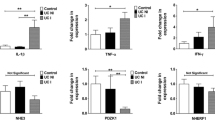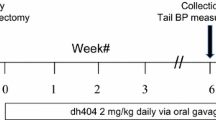Abstract
Objective
We investigated the role of toll-like receptor-4 (TLR-4) signal transduction in the regulation of Na-H exchanger-1 isoform (NHE-1) in ulcerative colitis (UC).
Methods
Colonic biopsies from control and UC patients were selected from four groups: controls (group 1), untreated UC patients (group 2), UC patients treated with 5′-aminosalicylic acid (5′-ASA) plus steroid (group 3), and UC patients treated with 5′-ASA plus azathioprine (AZA) (group 4). Patients presenting with abdominal pain (n = 13) and a normal colon on endoscopy served as controls. NHE-1, TLR-4, MyD88, NFkB and actin protein levels were estimated using Western blot analysis and sodium pump activity (PNPase) by a spectrophotometeric method. Myeloperoxidase (MPO) activity and histologic evaluation confirmed inflammation.
Results
PNPase activity decreased significantly (P < 0.05) in the untreated UC patients as compared to the controls or treated UC groups 3 and 4. There was a significant decrease of NHE-1 and a significant increase (P < 0.05) of TLR-4, MyD88 and NFkB protein levels in the untreated UC or 5′-ASA plus steroid treated UC patients as compared to the controls. NHE-1, TLR-4, MyD88 and NFkB protein levels were not significantly different in 5′-ASA plus AZA treated biopsies as compared to controls. The level of actin remained unaltered. Inflammatory cells’ infiltration and MPO activity increased significantly in the untreated UC, but was significantly lower in the treated UC groups 3 and 4 (P < 0.05).
Conclusions
These findings suggest that NHE-1 in UC is regulated by NFkB induced through TLR-4 and MyD88 signaling mechanism. These findings identify TLR-4 as a putative therapeutic target for IBD.





Similar content being viewed by others
References
Allgayer H, Kruis W, Paumgartner G, Wiebecke B, Brown L, Erdmann E. Inverse relationship between colonic [Na++K+]-ATPase activity and degree of mucosal inflammation in inflammatory bowel disease. Dig Dis Sci. 1988;33:417–422.
Siddique I, Hasan F, Khan I. Suppression of Na+/H+ exchanger isoform-3 in human inflammatory bowel disease: lack of reversal by 5’-aminosalicylate treatment. Scand J Gastroenterol. 2009;44:56–64.
Khan I, Siddique I, Al-Awadi FM, Mohan K. Role of Na+/H+ exchanger isoform-1 in human inflammatory bowel disease. Can J Gastroenterol. 2003;17:31–36.
Khan I, Collins SM. Altered expression of sodium pump isoforms in the inflamed intestine of Trichinella spiralis-infected rats. Am J Physiol. 1993;264:G1160–G1168.
Khan I. Molecular basis of altered contractility in experimental colitis: expression of L-type calcium channel. Dig Dis Sci. 1999;44:1525–1530.
Al-Jarallah A, Oriowo MA, Khan I. Mechanism of reduced colonic contractility in experimental colitis: role of sarcoplasmic reticulum pump isoform-2. Mol Cell Biochem. 2007;298:169–178.
Marzio L, Blennerhassett P, Chiverton S, Vermillion DL, Langer J, Collins SM. Altered smooth muscle function in worm-free gut regions of Trichinella-infected rats. Am J Physiol. 1990;259:G306–G313.
Khan I. Genetic diversity and pathogenic relevance of sodium hydrogen exchanger. In: McNamara AP, ed. Trends in RNA research. New York: Nova Science Press; 2006:191–223.
Fliegel L. Regulation of the Na[+]/H[+] exchanger in the healthy and diseased myocardium. Expert Opin Ther Targets. 2009;13:55–68.
Maher MM, Gontarek JD, Bess RS, Donowitz M, Yeo CJ. The Na+/H+ exchange isoform NHE3 regulates basal canine ileal Na + absorption in vivo. Gastroenterology. 1997;112:174–183.
Fallingborg J, Christensen LA, Jacobsen BA, Rasmussen SN. Very low intraluminal colonic pH in patients with active ulcerative colitis. Dig Dis Sci. 1993;38:1989–1993.
Khan I, Al-Awadi FM, Abul H. Colitis-induced changes in the expression of the Na+/H+ exchanger isoform NHE-1. J Pharmacol Exp Ther. 1998;285:869–875.
Khan I, Ali M. Altered expression of the Na+/H+ exchanger isoform-3 in experimental colitis: effect of garlic. Mol Cell Biochem. 1999;200:77–84.
Rousseaux C, Lefebvre B, Dubuquoy L, et al. Intestinal antiinflammatory effect of 5-aminosalicylic acid is dependent on peroxisome proliferator-activated receptor-gamma. J Exp Med. 2005;201:1205–1215.
Bultman E, Kuipers EJ, van der Woude CJ. Systematic review: steroid withdrawal in anti-TNF-treated patients with inflammatory bowel disease. Aliment Pharmacol Ther, 2010;32:313–323.
Thomas CW, Myhre GM, Tschumper R, et al. Selective inhibition of inflammatory gene expression in activated T lymphocytes: a mechanism of immune suppression by thiopurines. J Pharmacol Exp Ther. 2005;312:537–545.
Weersma RK, van Dullemen HM, Van der Steege G, Nolte IM, Kleibeuker JH, Dijkstra G. Review article: Inflammatory bowel disease and genetics. Aliment Pharmacol Ther. 2007;26:57–65.
Foteinou PT, Calvano SE, Lowry SF, Androulakis IP. In silico simulation of corticosteroids effect on an NFkB-dependent physicochemical model of systemic inflammation. PLoS One. 2009;4:e4706.
Lubbad A, Oriowo MA, Khan I. Curcumin attenuates inflammation through inhibition of TLR-4 receptor in experimental colitis. Mol Cell Biochem. 2009;322:127–135.
Sepúlveda SE, Beltrán CJ, Peralta A, et al. Inflammatory bowel diseases: an immunological approach. Rev Med Chil. 2008;136:367–375.
Fukata M, Abreu MT. TLR4 signaling in the intestine in health and disease. Biochem Soc Trans. 2007;35:1473–1478.
Laemmli UK. Cleavage of structural proteins during the assembly of the head of bacteriophage T4. Nature [Lond]. 1970;227:680–685.
Khan I, Thomas N, Haridas S. Expression and sub cellular localization of the sodium hydrogen exchanger isoform-1 in rat tissues: a possible functional relevance. Mol Cell Biochem. 2001;219:153–161.
Grover AK, Samson SE. Pig coronary artery smooth muscle: substrate and pH dependence of the two calcium pumps. Am J Physiol. 1986;251:C529–C534.
Leonard N, Bishop AE, Polak JM, Talbot IC. Expression of nitric oxide synthase in inflammatory bowel disease is not affected by corticosteroid treatment. J Clin Pathol. 1998;5:750–753.
Acknowledgments
The Kuwait University Research Administration is gratefully acknowledged for financial support through research grant # MB05/04, as well as Mr Abdul Kadir for his technical assistance.
Author information
Authors and Affiliations
Corresponding author
Rights and permissions
About this article
Cite this article
Siddique, I., Khan, I. Mechanism of Regulation of Na-H Exchanger in Inflammatory Bowel Disease: Role of TLR-4 Signaling Mechanism. Dig Dis Sci 56, 1656–1662 (2011). https://doi.org/10.1007/s10620-010-1524-7
Received:
Accepted:
Published:
Issue Date:
DOI: https://doi.org/10.1007/s10620-010-1524-7




